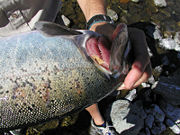
Columnaris
Encyclopedia

Disease
A disease is an abnormal condition affecting the body of an organism. It is often construed to be a medical condition associated with specific symptoms and signs. It may be caused by external factors, such as infectious disease, or it may be caused by internal dysfunctions, such as autoimmune...
in fish
Fish
Fish are a paraphyletic group of organisms that consist of all gill-bearing aquatic vertebrate animals that lack limbs with digits. Included in this definition are the living hagfish, lampreys, and cartilaginous and bony fish, as well as various extinct related groups...
which results from an infection
Infection
An infection is the colonization of a host organism by parasite species. Infecting parasites seek to use the host's resources to reproduce, often resulting in disease...
caused by the gram negative, aerobic, rod shaped bacterium
Bacteria
Bacteria are a large domain of prokaryotic microorganisms. Typically a few micrometres in length, bacteria have a wide range of shapes, ranging from spheres to rods and spirals...
Flavobacterium columnare
Flavobacterium columnare
Flavobacterium columnare is a thin Gram-negative rod bacterium of the genus Flavobacterium. The name derives from the way in which the organism grows in rhizoid columnar formations....
. It was previously known by the names of bacillus columnaris, chondrococcus columnaris, cytophaga columnaris and flexibacter columnaris. The bacteria is ubiquitous in fresh water, and cultured fish reared in ponds or raceways are the primary concern – with disease most prevalent in air temperatures above 12–14⁰C. The disease is highly contagious and the outcome is often fatal. It is not zoonotic
Zoonosis
A zoonosis or zoonoseis any infectious disease that can be transmitted from non-human animals to humans or from humans to non-human animals . In a study of 1415 pathogens known to affect humans, 61% were zoonotic...
.
Causes
The bacterium usually enters fish through gills, mouth, or small wounds, and is prevalent where high bio-loadBio-load
An aquarium term from biology, the biological demand is the nitrogen processing demand placed upon the material, chemical and biological filters by uneaten food, decomposing inhabitants, accumulated organics and waste produced by livestock, foods and plant matter in the aquarium filtration system...
exists, or where conditions may be stressful due to overcrowding or low dissolved oxygen levels in the water column. The bacteria can persist in water for up to 32 days when the hardness is 50 ppm or more.
Symptoms
An infection will usually first manifest in fish by causing frayed and ragged fins. This is followed by the appearance of ulcerations on the skin, and subsequent epidermal loss, identifiable as white or cloudy fungus-like patches – particularly on the gill filaments. Mucus often also accumulates on the gills, head and dorsal regions. Gills will change colour, either becoming light or dark brown, and may also manifest necrosis. Fish will breathe rapidly and laboriously as a sign of gill damage. Inappetance and lethargy are common, as are mortalities – especially in young fish.Diagnosis
Bacteria can be isolated from gills, skin and the kidneys. For definitive diagnosis the pathogen should then be cultured on reduced nutrient agar. Inhibiting contaminant growth on the agar by adding antibiotics and keeping the temperature at 37°C should improve culture results. Colonies are small, 3–4 mm in diameter and grow within 24 hours. They are characteristically rhizoid in structure and pale yellow in colour.Prognosis
Ulcerations develop within 24 to 48 hours. Fatality occurs between 48 to 72 hours if no treatment is pursued; however, at higher temperatures death may occur within hours. Other symptoms may accompany the disease including lethargy, color loss, redness around the infection site, loss of appetite and twitching or rubbing the body against objects.Treatment
As Flavobacterium columnare is a gram-negative bacteria, fish can be treated with a combination of the antibiotics Furan-2 and Kanamycin administered together. Medicated food containing oxytetracyclineOxytetracycline
Oxytetracycline was the second of the broad-spectrum tetracycline group of antibiotics to be discovered.Oxytetracycline works by interfering with the ability of bacteria to produce proteins that are essential to them. Without these proteins the bacteria cannot grow, multiply and increase in numbers...
is also an effective treatment for internal infections, but resistance is emerging. Potassium permanganate, copper sulphate and hydrogen peroxide can also be applied externally to adult fish and fry but can be toxic at high concentrations. Vaccines can also be given in the face of an outbreak or to prevent disease occurrence.
External links
- Columnaris Disease, expert reviewed and published by Wikivet at http://en.wikivet.net/Columnaris_Disease, accessed 31/08/2011.
- Fish disease articles: Columnaris disease
- Disease profile: Flexibacter Columnaris
- Columnaris disease

